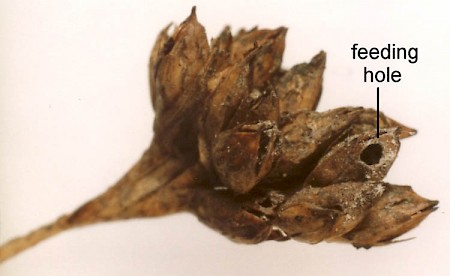Coleophora maritimella

37.078 BF585
Coleophora maritimella
Newman, 1873
Wingspan 9 - 11 mm
This species is widespread on English and Welsh coastal saltings where Sea rush (Juncus maritimus) grows. It has also been recorded on the Firth of Forth and in eastern Ireland.
The adult is similar to many other whitish species of Coleophora, and examination of the genitalia is advised. The larval case, made from a hollowed seed of the foodplant, is well camouflaged and easily overlooked.
The larva can be found on Juncus maritimus seedheads, both standing and prone on the ground, from September to May. Seedheads with feeding holes should be gathered and left in a lidded container for the larvae to disclose themselves by crawling up the sides. Records should not be made purely on the basis of feeding holes, as C. glaucicolella, another species often abundant on saltings, makes similar holes in Juncus maritimus. Care is needed in the identification of the foodplant, especially when dealing with dead seedheads, as the similar Juncus gerardii supports larvae of Coleophora adjunctella feeding on seeds in the same manner (See Collins guide to the grasses, sedges, rushes and ferns of Britain and northern Europe).
Pupation is on a plant stem in May and June.
The adult flies from late June to early August at night and at sunrise. It comes to light, sometimes at a distance from the coast.

 UKMoths
UKMoths 

